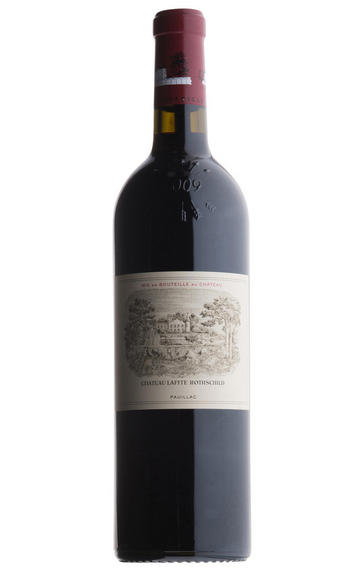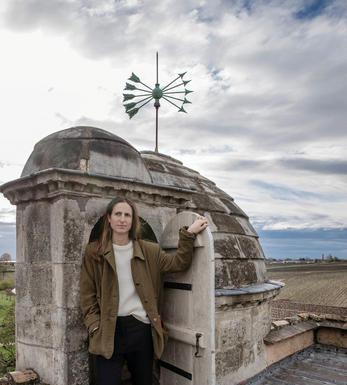
2021 Château Lafite Rothschild, Pauillac, Bordeaux

Critics reviews
The 2021 Lafite-Rothschild, which was aged in 90% new oak, has a deep, almost opaque hue. This has quite an arresting bouquet with dense blackberry, sous-bois and pencil box scents, quintessential Lafite aromas with nuanced floral scents surfacing with time. The palate is medium-bodied, though with more weight than you would expect given the growing season. The Cabernet Sauvignon imparts graphite and almost briny elements into the aromatic profile. Sapid and classic in style, head winemaker Eric Kohler suggests that it is a return to the style of Lafite-Rothschild of the nineties in terms of freshness. I concur.
Drink 2030 - 2070
Neal Martin, vinous.com, (May 2022)
Deep in colour, has grip and presence. Loganberry, blueberry, wet stones, hawthorn, forest floor, this is a long-ageing Lafite, not one that I would rush to open. It delivers tannic power from beginning to end, with density and juice and length, a reminder that Lafite manages to perform strongly in so many different styles of vintage. Delivering right at the very top of Pauillac. 1st year organic conversion. 90% new oak. No frost at the estate, yields of 34hl/h, harvest September 22 to October 8. 40% 1st wine.
Drink 2028 - 2044
Jane Anson, janeanson.com (May 2022)
Deep crimson hue. Customary elegance rather than power. Perfumed nose, attractive fruit and a surprising density of tannin (15% press wine to bolster the structure). Quite discreet and measured in its form but good length and should improve further in bottle.
Drink 2030 - 2050
James Lawther, jancisrobinson.com (May 2022)
A brilliant wine that shares some similarities with the formidable 1996, the 2021 Lafite Rothschild wafts from the glass with inviting aromas of dark berries, cigar box, loamy soil, black truffle and violets. Medium to full-bodied, deep and layered, it's rich and concentrated, with beautifully powdery tannins, lively acids and a long, saline finish. Of course, this isn't as dramatic as the 2020 or 2019 out of the gates, but the 2021 is a brilliant success in its own right. What's more, its structure and balance mean that it is likely to prove almost immortal. It's a blend of 96% Cabernet Sauvignon, 3% Merlot and 1% Petit Verdot, which is one of the all-time highest percentages of Cabernet Sauvignon chez Lafite.
William Kelley, Wine Advocate (Apr 2022)
Polished and refined with a firm, fine and linear tannin structure. Harmonious. Perfumed violets, roses and subtle licorice. All in balance here, with precise layers of black fruit, minerals and pencil lead. Rather seamless. Firm, yet fine and sleek to the end. Very classy. Fine-velvet texture. 96% cabernet sauvignon, 3% merlot and 1% petit verdot.
James Suckling, jamessuckling.com (May 2022)
About this WINE

Château Lafite Rothschild
The iconic Château Lafite Rothschild was classified as a first growth in 1855 and has been in the Rothschild family since 1868. Today, Lafite is headed up by Saskia de Rothschild, daughter of long-time steward Baron Eric de Rothschild.
Château Lafite Rothschild is an iconic first-growth property in the Pauillac appellation of Bordeaux, France. It achieved its top-tier rank in 1855 and has been in the Rothschild family since 1868. Today, Lafite is headed up by Saskia de Rothschild, daughter of long-time steward Baron Eric de Rothschild.
The property is located at the northern tip of Pauillac, separated by St Estèphe by marshland and the Jalle de Breuil stream. Two areas of the vineyard are particularly notable: the gravel plateau, which is the heart of the grand vin; and the Plateau de Carruades, from which Lafite’s second wine takes its name. The vineyard is planted mostly to Cabernet Sauvignon (70%), along with Merlot (25%), Cabernet Franc (3%) and Petit Verdot (2%).
A new cellar was completed here in time for the 2011 harvest, with a combination of stainless steel and concrete tanks, of varying sizes. The barrels come from Lafite’s own cooperage, located not far from the property.
In addition to its 110 hectares of vines, the estate has 300 hectares of woods and marshes. The team consider this to be an integral part of the ecosystem.

Pauillac
Pauillac is the aristocrat of the Médoc boasting boasting 75 percent of the region’s First Growths and with Grand Cru Classés representing 84 percent of Pauillac's production.
For a small town, surrounded by so many familiar and regal names, Pauillac imparts a slightly seedy impression. There are no grand hotels or restaurants – with the honourable exception of the establishments owned by Jean-Michel Cazes – rather a small port and yacht harbour, and a dominant petrochemical plant.
Yet outside the town, , there is arguably the greatest concentration of fabulous vineyards throughout all Bordeaux, including three of the five First Growths. Bordering St Estèphe to the north and St Julien to the south, Pauillac has fine, deep gravel soils with important iron and marl deposits, and a subtle, softly-rolling landscape, cut by a series of small streams running into the Gironde. The vineyards are located on two gravel-rich plateaux, one to the northwest of the town of Pauillac and the other to the south, with the vines reaching a greater depth than anywhere else in the Médoc.
Pauillac's first growths each have their own unique characteristics; Lafite Rothschild, tucked in the northern part of Pauillac on the St Estèphe border, produces Pauillac's most aromatically complex and subtly-flavoured wine. Mouton Rothschild's vineyards lie on a well-drained gravel ridge and - with its high percentage of Cabernet Sauvignon - can produce (in its best years) Pauillac's most decadently rich, fleshy and exotic wine.
Latour, arguably Bordeaux's most consistent First Growth, is located in southern Pauillac next to St Julien. Its soil is gravel-rich with superb drainage, and Latour's vines penetrate as far as five metres into the soil. It produces perhaps the most long-lived wines of the Médoc.
Recommended Châteaux
Ch. Lafite-Rothschild, Ch. Latour, Ch. Mouton-Rothschild, Ch. Pichon-Longueville Baron, Ch. Pichon Longueville Comtesse de Lalande, Ch. Lynch-Bages, Ch. Grand-Puy-Lacoste, Ch, Pontet-Canet, Les Forts de Latour, Ch. Haut-Batailley, Ch. Batailley, Ch. Haut-Bages Libéral.

Cabernet Sauvignon Blend
Cabernet Sauvignon lends itself particularly well in blends with Merlot. This is actually the archetypal Bordeaux blend, though in different proportions in the sub-regions and sometimes topped up with Cabernet Franc, Malbec, and Petit Verdot.
In the Médoc and Graves the percentage of Cabernet Sauvignon in the blend can range from 95% (Mouton-Rothschild) to as low as 40%. It is particularly suited to the dry, warm, free- draining, gravel-rich soils and is responsible for the redolent cassis characteristics as well as the depth of colour, tannic structure and pronounced acidity of Médoc wines. However 100% Cabernet Sauvignon wines can be slightly hollow-tasting in the middle palate and Merlot with its generous, fleshy fruit flavours acts as a perfect foil by filling in this cavity.
In St-Emilion and Pomerol, the blends are Merlot dominated as Cabernet Sauvignon can struggle to ripen there - when it is included, it adds structure and body to the wine. Sassicaia is the most famous Bordeaux blend in Italy and has spawned many imitations, whereby the blend is now firmly established in the New World and particularly in California and Australia.


Buying options
Add to wishlist
Description
Only a very limited quantity of this wine is available, and sales are handled by our Account Managers. You can find out more about this service here. If you would like to hear about Bordeaux 2021 En Primeur releases, sign up here. You can browse our range of new releases here.
Cabernet Sauvignon 96%, Merlot 3%, Petit Verdot 1%
This has one of Lafite’s highest-ever proportions of Cabernet Sauvignon (alongside 2016, 1994 and ’61). The wine is finely sculpted, with a bell-like clarity and harmony that only comes from the great terroirs. It would be wrong to call the wine powerful, yet it has an unmissable presence. Descriptions at this level are usually elusive; there are snatches of floral perfume wrapped into hints of tapenade, graphite, tobacco and much more. What truly beguiles are the extraordinary tannins, sapid and stiletto-like, that glint in every facet of the wine. They refresh as well as control the wine and are the epitome of great Cabernet. After the ebullience of recent vintages, this is a wine that makes you think, and one built to last for decades. Drink 2030-2055.
Our score: 18.5/20
Berry Bros. & Rudd, April 2022
wine at a glance
Delivery and quality guarantee